In this article, I explore Mailinator and the whole disposable email approach, from A to Z, no frills.
I’ll tell you all you need to know about the tool, show you how it works, clarify what you can do with it, and provide you with several alternatives, both for disposable email addresses and for testing.
What is Mailinator?
Mailinator is an online disposable email service or, as they call it, a public email. Simply put, it’s a web service that accepts and displays emails sent to any possible address on the Mailinator domain.
And here’s what Mailinator is used for:
- Signing up for different services
Personally, I use Mailinator when I’m trying out various tools and services for articles on the Mailtrap blog and YouTube channel.
With Mailinator’s disposable email addresses, I can create accounts pretty much anywhere I want without having to use and reveal my personal email address. By doing this, I easily dodge those spammy emails you receive after registering for a tool or service (e.g., promotional messages, newsletters. etc.).
To see how I register with the disposable email addresses, [click here].
- Sporadic testing of email-sending capabilities
I say sporadic because lacking a whole bunch of testing features (e.g., sandbox, spam check, etc.) Mailinator is not a dedicated email testing solution and is quite impractical to use. However, in case you need a quick check, be my guest, although I don’t recommend using a dummy email for testing.
If you’re interested in a time-proven way to go about email testing, allow my colleague Veljko, a veteran in the email game, to take you on a personal journey through email testing in his dedicated article on the topic.👈
- Verifying your website functionality
When I say ‘verifying your website functionality,’ I actually mean testing sign-up forms, form submitting, subscribing, etc. Mailinator is great for this, especially if you’re a QA who needs to test these functionalities through and through, as you wouldn’t need to create a new email account for every registration, for example.
If you want to learn how to automate the sign-up process via Selenium, read the official guide, or if you’re a visual learner, watch the Mailinator video.
- View how your emails look for recipients
Last but not least, you can use Mailinator’s disposable emails to check how the email actually looks for your recipients.
But, as with everything in life, there’s always a ‘but’ and there’s always a catch. 🙂
Although you can check how your dynamic content looks, Mailinator doesn’t show you how it looks for different clients/browsers or pinpoint the faulty lines of code, which is a big no-no in my book.
And here’s another ‘but’: if you’re interested in an efficient testing solution, I’ve got just the right alternative, which I go over in-depth [later in the article].
Is it safe to use Mailinator?
If you’re wondering whether Mailinator is safe to use, I feel you—I wonder the same whenever I’m reviewing any tool or service out there for our blog.
Here’s what you should be aware of in the case of Mailinator:
- Public (Free) domains
Any emails you send to Mailinator’s public domains (e.g., @mailinator.com) are completely public. So, anyone can access your emails without even having to log in or sign up for Mailinator, which means there’s no privacy at all for the emails received in these public inboxes.
- Private (Subscriber-Only) domains
For private domains provided to paid users, Mailinator employs multiple security measures, including HTTPS for web traffic, TLS encryption for SMTP servers, and secure handling of access keys.
Additionally, the infrastructure includes firewalls and redundant systems, which significantly improves data security and availability.
- Infrastructure security
If you’re interested in the deets, you should know that Mailinator’s infrastructure is hosted on Linode with various certifications, including SOC 1 Type 2, SOC 2 Type 2, HIPAA Type 1, HITECH, and PCI DSS.
Mailinator’s secure architecture is also maintained with regular key rotations and an isolated environment for both development and production.
- Incident response
Worst comes to worst: Mailinator has a defined protocol in place dedicated to responding to security incidents, ensuring that any potential vulnerabilities are addressed without much delay.
- Final verdict
If you send test emails with sensitive content to the public domain, you definitely won’t be safe.
On the other hand, a subscription to the service gets you private domains, meaning you’ll be in the clear, so you can sit back and sip a worry-free martini. 🍸
For peace of mind and a bit more information, consult the Mailinator security page.
Mailinator review
As you might have noticed by now, Mailinator’s free and paid functionality differ a lot. So, I’ll review them separately so you can get a clearer picture of the service’s subscription plans.
Free features
With the free Mailinator plan, which doesn’t require a signup, you get (only) an endless number of receive-only public inboxes, and that’s it—simple as that.
According to Mailinator, you could technically use a billion different inboxes every day for the rest of your life and never come close to using them all up.
Fun statistics aside, here are some things you should be aware of when it comes to the free features:
- Message retrieval pause – You can pause the retrieval of messages in any of the inboxes at any time, which, for example, can be useful if you want to perform bulk action on an inbox without any new emails continually arriving and disrupting the process.
- Automatic deletion of messages – All messages in any inbox are automatically deleted after several hours.
- Since there is no exact time stated, I’ve tested it with a bunch of inboxes and had results. Some emails had been deleted in around 10 minutes, while others managed to survive several hours.
- Lack of support for email attachments – Unfortunately, you can’t receive any email attachments in your public inbox. You can send a message with an enclosed file to it, but you’ll receive the email without the attachment.
As you can probably figure out for yourself, Mailinator’s free functionality is pretty much limited only to registration and some ultra-light email testing, which I’d personally avoid.
Now, let’s use Mailinator’s disposable address to sign up for “The Front Page of the Internet.” Of course, I’m talking about Reddit.
Everyone needs a throwaway account every now and then, so I figured it would be the perfect website to test the free Mailinator functionality.
Here’s what you need to do:
- Visit the official Mailinator website
- Navigate to the ‘Public Inbox’ page
- Write down the email handle you want and hit ‘Go’
- Note: you can come up with any combination of Roman letters and numbers, and whichever one you choose, the domain name will be ‘mailinator.com’

- Use the newly come-up-with email address to create an account

- Refresh the ‘Public Inboxes’ page
- Open my verification email and confirm it
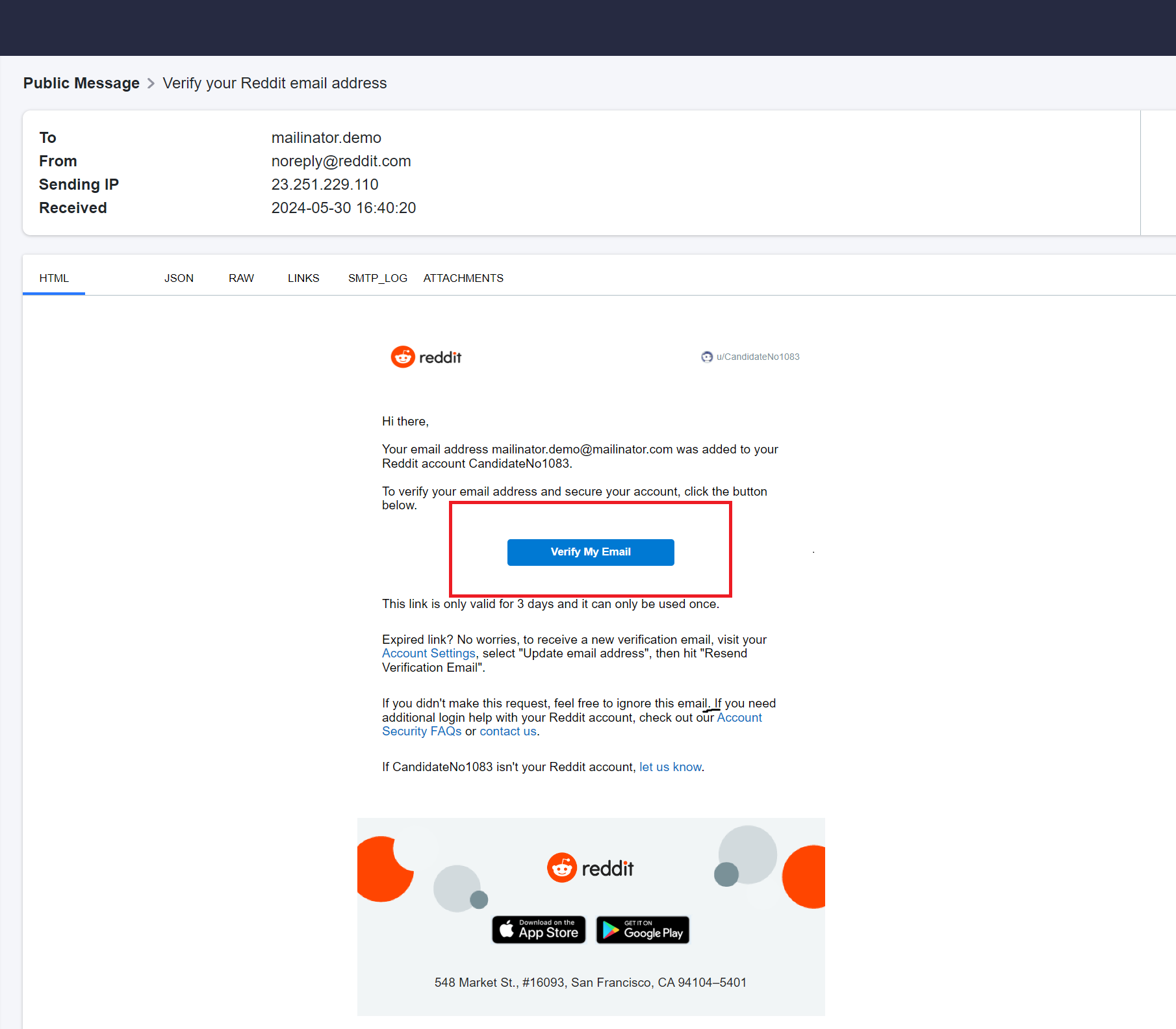
And voila, I’ve successfully avoided using my real address to sign up for a website.
Paid features
Some of the most notable paid Mailinator features include:
- Private domain – Even with the most affordable Mailinator pricing plan, you get your own private domain, which no one besides you and, depending on the plan, your teammates can access.
- Increased storage – Also depending on the plan you choose, you can get up to 100MB of storage for your emails. This means that they won’t be auto-removed after several hours as is the case with the free plan.
- You can get more than 100MB of storage if you opt for the Enterprise plan and talk to the sales team.
- API access and webhooks – With Mailinator’s API, which supports webhooks and real-time streaming, you can say goodbye to manual testing and automate the retrieval of your emails, test your email workflows, or automate the verification process.
- For more information on automating the verification process, check out Mailinator’s guide or watch the video they’ve prepared for you. Or, give the rich API documentation a read.
- Better email handling – You can create rules to route messages, delete them, and click links. For example, you can check subscriptions, registrations, password resets, etc.
- SMS testing – Although available only at higher plans, this feature is designed primarily for developers and QA teams who need to verify SMS workflows (e.g., 2FA, OTPs, and other SMS notifications).
Pricing
Disclaimer: The subscription plans, their features, and prices are up-to-date as of writing this article, but they could be different when you’re reading it as they’re prone to change.
- Public – Free / $0 Per month
I already went over the Free Mailaintor features, so you know the deal. Nonetheless here’s a table so you can compare it with other plans below.
| Unlimited Public Inboxes | Temporary Storage | No Sign-up Required | Free to Use |
| 24/7 Uptime Monitoring | SMS Testing ❌ | API Access ❌ | Webhooks ❌ |
| Routing Rules ❌ | Load Testing ❌ | Email Support ❌ | Phone Support ❌ |
| Email Attachments ❌ | 📧 | 📧 | 📧 |
- Verified Pro / $0 with Verification
No, it’s not a typo, Mailinator does, in fact, offer a free plan that includes a private domain and some additional features, with a limit to 1K emails per month.
And I must admit, it’s a nice gesture by the Mailinator team towards those who aren’t ready to commit to a paid plan but want to try features that come with one.
| Unlimited Private Inboxes | 1 Private Domain | 10MB Permanent Storage | 10 Emails/Sec |
| 1K Emails/Mo | 1 Single User | SMS Testing ❌ | API Access |
| Webhooks | Routing Rules | Load Testing ❌ | Email Support |
| Phone Support ❌ | Email Attachments ❌ | Usage Statistics | 24/7 Uptime Monitoring |
However, there’s a catch. To get the Verified Pro account, you need to enter your company email, full name, intended use case, and phone number or LinkedIn profile.
Ironically enough, when I tried signing up for this plan, I didn’t get my verification email and couldn’t log in afterwards. Twice. But don’t let that stop you: be my guest and try your luck at it yourself if you’re interested.
- Business / $99 Per month or $79 when billed yearly
Best for small to medium-sized businesses, business plan is the most popular choice at Mailinator, being a middle ground, both when considering the features and the price.
| Unlimited Private Inboxes | 1 Private Domain | 50MB Permanent Storage | 20 Emails/Sec |
| 100K Emails/Mo | 5 Team Seats | SMS Testing | API Access |
| Webhooks | Routing Rules | Load Testing ❌ | Email Support |
| Phone Support ❌ | Email Attachments | Usage Statistics | 24/7 Uptime Monitoring |
| Easy Team Management | System Status Dashboard | Supports SSO | Pay by Invoice |
| Upgrades Available | Standard T’s & C’s | 📧 | 📧 |
Note that Mailinator offers a two-week free trial for this plan, which you can request by following this link. Luckily, I successfully received the verification email for this plan and was able to take its features for a test ride.
- Business Plus / $199 Per month or $159 when billed yearly
The Business Plus plan doubles down on what the regular Business model offers and includes some notable perks such as phone support and Load Testing.
| Unlimited Private Inboxes | 3 Private Domains | 100MB Permanent Storage | 100 Emails/Sec |
| 300K Emails/Mo | 10 Team Seats | SMS Testing | API Access |
| Webhooks | Routing Rules | Load Testing | Email Support |
| Phone Support | Email Attachments | Usage Statistics | 24/7 Uptime Monitoring |
| Easy Team Management | System Status Dashboard | Supports SSO | Pay by Invoice |
| Upgrades Available | Standard T’s & C’s | 📧 | 📧 |
- Enterprise / From $594 Per month or $459 when billed yearly
The Enterprise plan is designed for large organizations and includes all the possible features Mailinator has to offer.
| Unlimited Private Inboxes | 5+ Private Domains | Custom Permanent Storage | 200 Emails/Sec |
| 3MM+ Emails/Mo | 50+ Team Seats | SMS Testing | API Access |
| Webhooks | Routing Rules | Load Testing | Email Support |
| Phone Support | Email Attachments | Usage Statistics | 24/7 Uptime Monitoring |
| Easy Team Management | System Status Dashboard | Supports SSO | Pay by Invoice |
| Accelerated Feature Request Support | Custom Terms & Conditions | 📧 | 📧 |
One more thing I noticed worth mentioning is that Enterprise users can request features from the Mailinator team that don’t exist already and come up with their own terms and conditions.
User reviews and ratings
As in all of my reviews, I checked out what the community says and how it rates the tool or service I’m trying out.
- Capterra 4.6/5 🌟 – Besides being praised for its core functionality, Mailinator receives a ton of positive reviews from developers and QA testers as it allows them to automate their MFA, E2E, and other testing flows.
- G2 4.6/5 🌟 – Similarly to reviews from Capterra, Mailinator is also praised by dev teams on G2. I also noticed that people on G2 like the fact that the service doesn’t require a sign-up.
I also didn’t forget social media, and I’ve scouted both X(Twitter), and, of course, Reddit. Both platforms have mostly positive reviews, with Reddit having a few posts regarding the functionality.
As you can see for yourself, Mailinator is pretty much loved by folks from all over the place for its disposable email service. So, hurray for Mailinator! 🥳
Alternatives for disposable emails
Developed way back in 2001 by Manybrain, Mailinator is one of the oldest disposable email providers in the game. However, it’s neither the best nor the only solution out there.
Here are some alternatives I’ve used in the past and am always happy to recommend:
| Alternative | Attachments | Sending Emails | Spam Filter | Mobile App | Sign up Required |
| Guerilla Mail | Up to 150MB | ✅ | ✅ | ❌ | ❌ |
| MailDrop | ❌ | ❌ | ✅ | ❌ | ❌ |
| 10 Minute Mail | ❌ | ❌ | ✅ | ✅ | ❌ |
| Temp Mail | ❌ | ❌ | ✅ | ✅ | ❌ |
| FakeMail | ❌ | ❌ | ✅ | ✅ | ❌ |
How to test emails in Mailinator using a disposable email
And finally, we’ve come to, in my opinion, the most interesting part of the article: email testing with Mailinator.
First, I’ll show you how to send a basic test email with Gmail. Then, for demonstrative purposes, I’ll showcase a simple email-sending functionality.
Testing emails with Gmail
To send a basic test email to Mailinator inbox with Gmail, follow these steps:
- Send a test email from your Gmail account to your chosen email handle + @mailinator.com
- For this example, I’ll use ‘mailinator.email.test@mailinator.com’
- Navigate to the ‘Public Inbox’ page and type in your chosen email handle, which will show your fake address and any messages it received

- Open the email you’ve just sent and preview it in different forms
- Sent from my regular Gmail account, this email took ~10 seconds to arrive
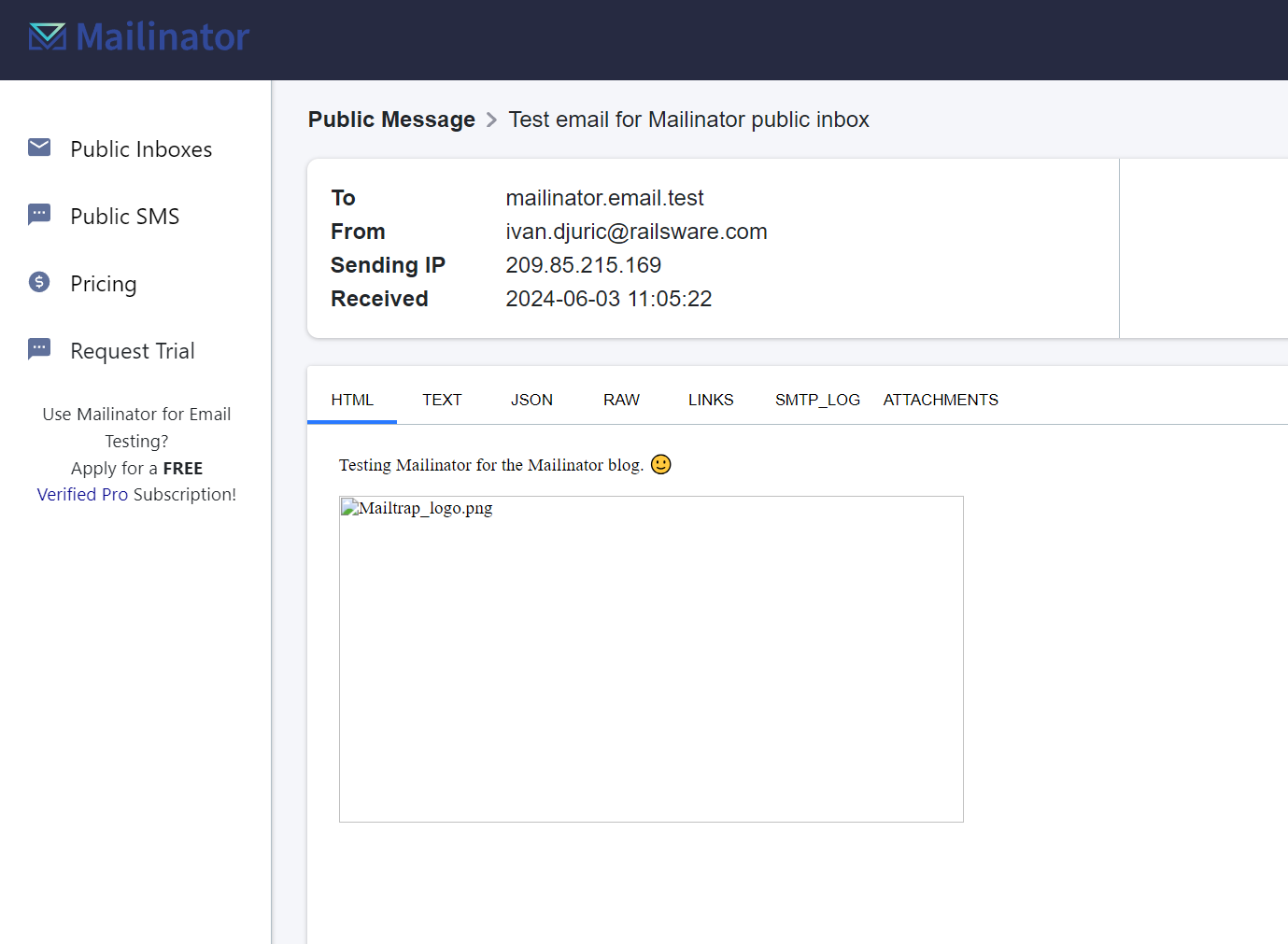
As you can see, Mailinator supports email subject, To and From headers, and recognizes text and HTML parts. However, the image in the message body is not displayed at all because it’s a free account.
Testing emails with Node.js and Nodemailer
For this test, I’ve used Nodemailer and Mailtrap SMTP, my favorite combination.
Nodemailer is quite straightforward to use, whereas Mailtrap provides me with a reliable SMTP with robust sending capabilities, ensuring my emails reach recipients’ inboxes, or, in this case, the Mailinator public inbox.
Here’s what my Nodemailer configuration looks like:
const nodemailer = require('nodemailer');
const transporter = nodemailer.createTransport({
host: 'live.smtp.mailtrap.io',
port: 587,
secure: false,
auth: {
user: "api",
pass: "1a2b3c4d5e6f7g1a2b3c4d5e6f7g"
}
});
const mailOptions = {
from: 'info@mailtrap.club',
to: 'mailinator.email.test@mailinator.com',
subject: 'Test email for Mailinator public inbox',
text: 'Testing Mailinator for the Mailtrap blog. :)!'
};
transporter.sendMail(mailOptions, (error, info) => {
if (error) {
console.error('Error, error');
} else {
console.log('Email sent: ', info.response);
}
});After running the script, I visited the Mailinator public inbox, and voila, my email is waiting for me there!

Why using dummy emails for testing doesn’t work
I’m gonna be honest with you: if you’re looking for a disposable email service for registering without your personal address, Mailinator really is one of your best bets.
However, Mailinator, or any other similar service for that matter, falls short for purposes of email testing, because of:
- Domain reputation – If you send a massive amount of testing emails to an address with low engagement, like Mailinator’s, the chances are quite high that your domain reputation will be hit. And, as you probably know, domain reputation has a direct impact on email deliverability and inbox placement.
- Accidental sends – No matter how careful you are, accidents happen. And when testing your email-sending functionality with a disposable address, you’re facing a big risk of accidentally inserting a real email address along with a disposable one, meaning your test email will land in a real inbox.
- HTML preview – Although you can preview your emails in raw and JSON, Mailinator can’t tell you how your emails look on different clients/browsers and whether there’s any faulty code.
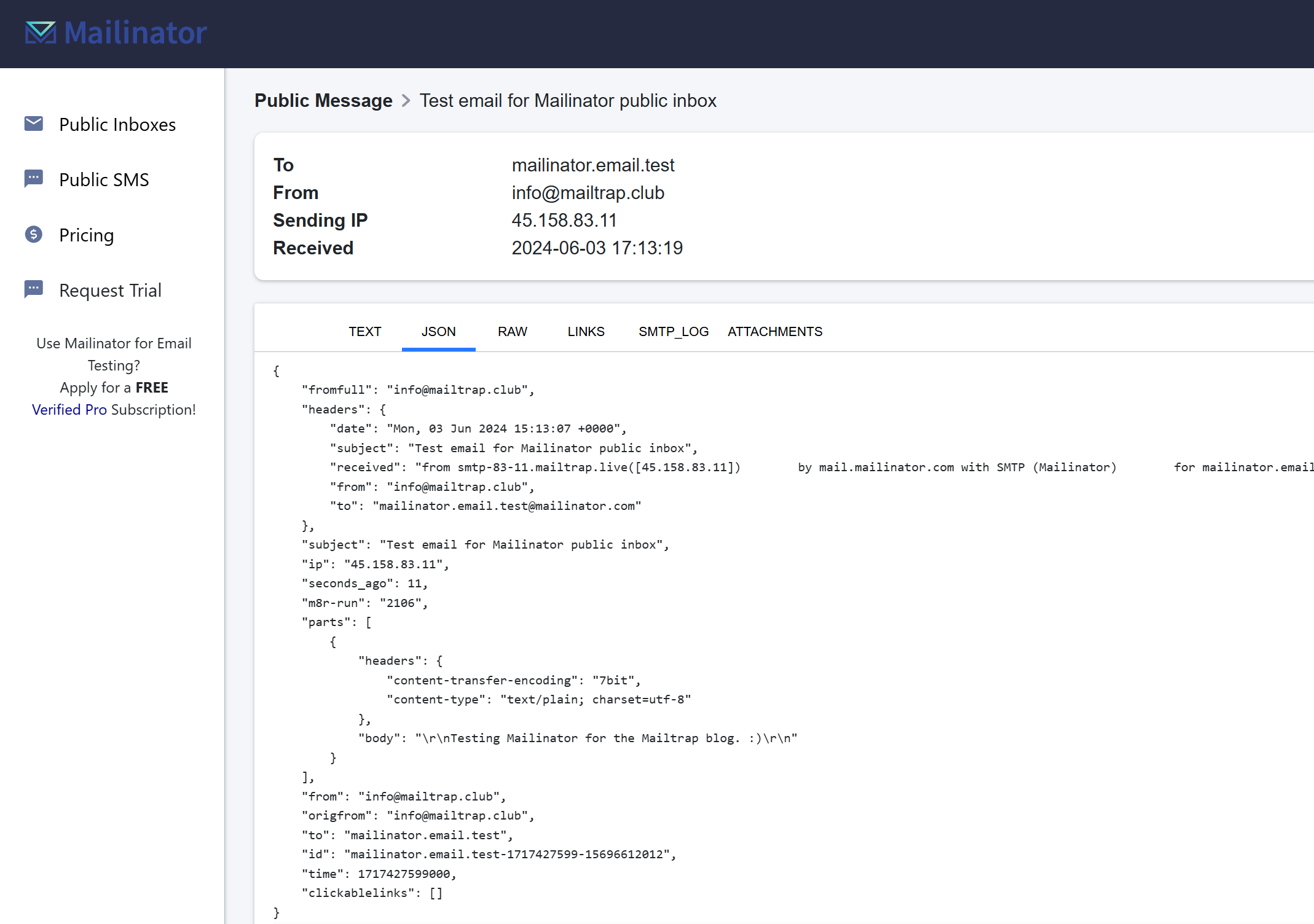
- Pricing – Now, I’m not saying Mailinator isn’t affordable, but what you get for your money’s worth in terms of email testing might just not be it, especially if you compare what you’d get from dedicated email testing solutions.
Alternative to Mailinator for email testing
If you’re looking for an alternative to Mailinator, don’t worry—I’ve got you covered.
One such alternative is Email Sandbox.
Email Sandbox is designed to simplify testing by providing developers with a safe sandbox environment where you can test emails without affecting your own domain or accidentally sending messages to real addresses.
Unlike with Mailinator, with Email Sandbox you can preview your emails in HTML with dynamic content and see how they look on phones, tables, and big displays.
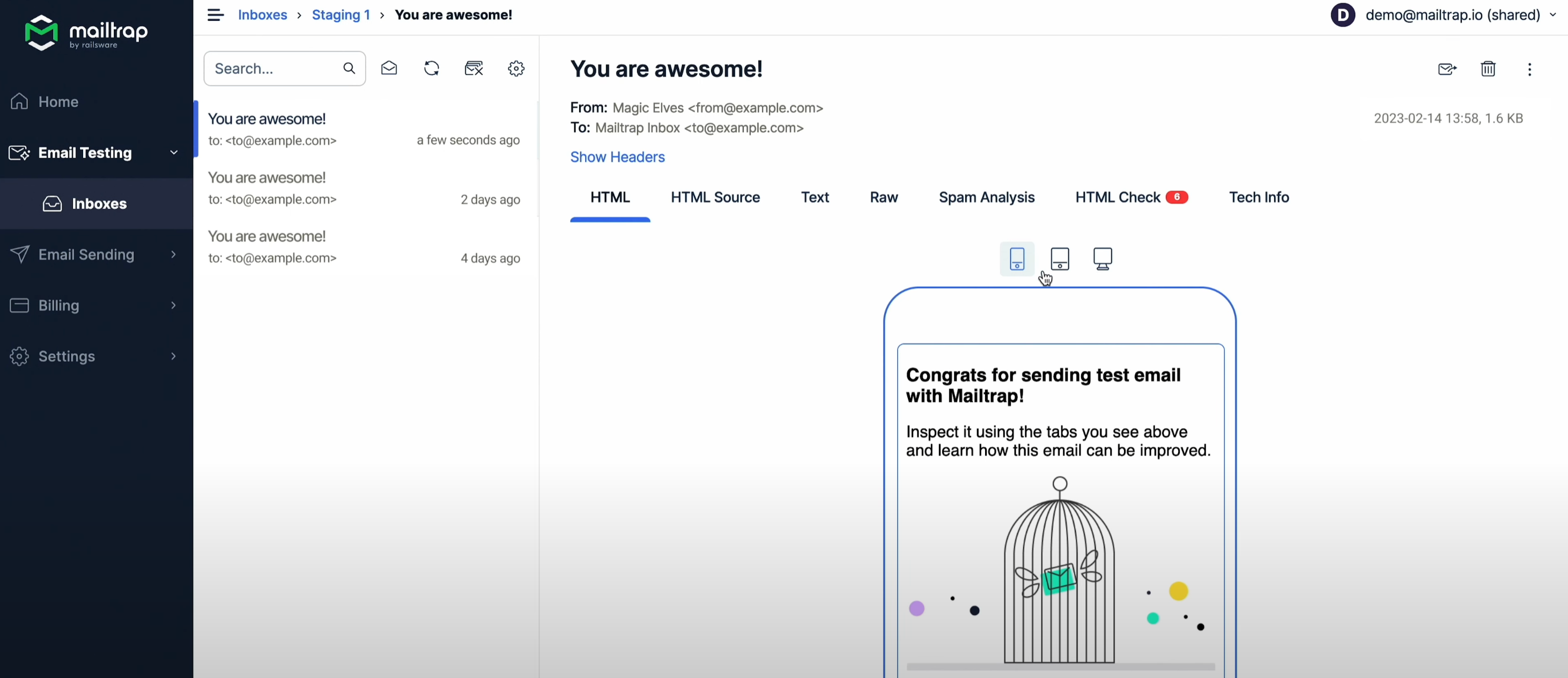
Additionally, you can check whether your code is rendered correctly on different browsers/clients.
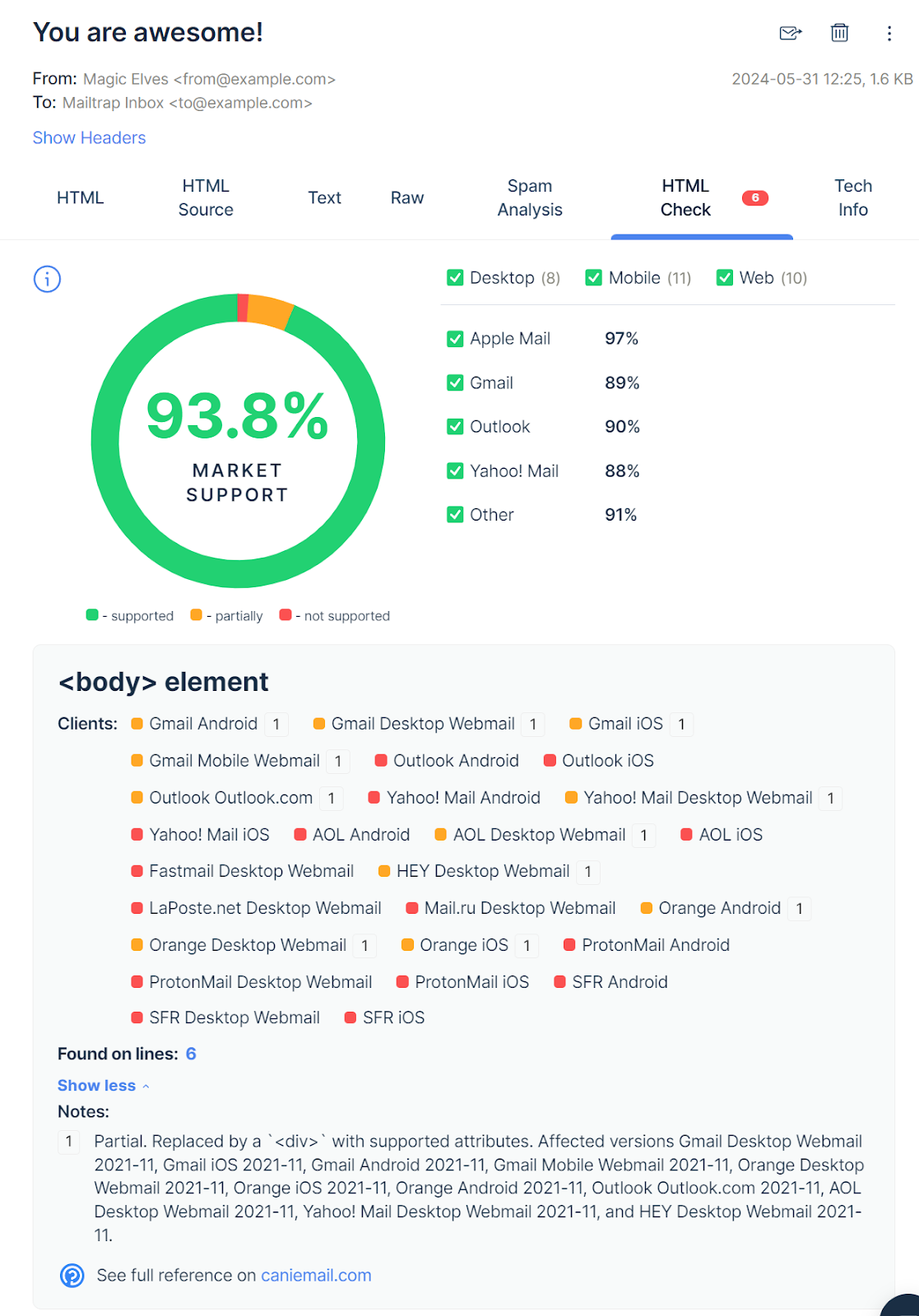
You can then simply click on the number next to Found on lines, which will take you to the HTML Source tab, where you can easily see the faulty line of code and fix/remove it.
And as if you didn’t have enough of tables in this article, here’s another one summarizing the difference in testing-specific features offered by Email Sandbox and Mailinator:
| Feature | Email Sandbox | Mailinator |
| Email sandbox | ✅ | ❌ |
| Email preview | ✅ | ✅ |
| HTML check | ✅ | ❌ |
| Email headers | ✅ | ❌ |
| Multiple inboxes | ✅ | ❌ |
| Email templates | ✅ | ✅ |
| SMS Testing | ❌ | ❌ |
| Automatic authentication | ✅ | ❌ |
| Free plan | ✅ | ✅ |
| Scalable pricing | ✅ | ❌ |
As you can see, comparing a dedicated email testing service (Email Sandbox) with a disposable email service (Mailinator) is like comparing Ronaldo to Novak Djokovic. Ronaldo dominates the football field, but Djokovic would outshine him on the tennis court, each excelling in their own sport.
Now, let me break down some of these features offered by Email Sandbox:
- Spam check – Keep your spam score under 5 and significantly reduce any potential email deliverability issues once your app moves to production.

- Email headers – Via the Tech Info tab, you can easily see the original header values, which can be altered by MTAs or email service providers when you send emails. With this data, you’ll have more than enough information for debugging purposes.
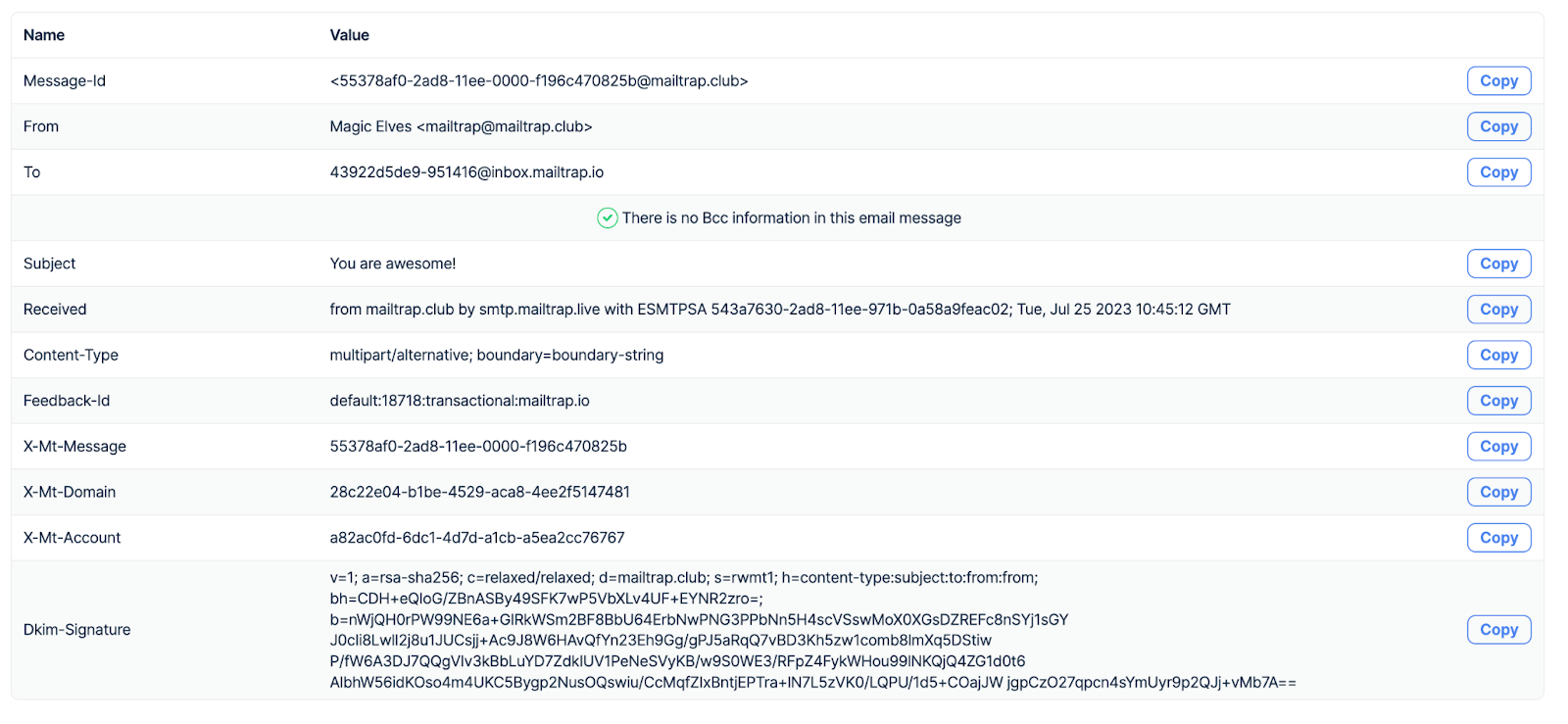
- Multiple inboxes – Easily share the testing process with your team members, create new projects, and add multiple objects within.
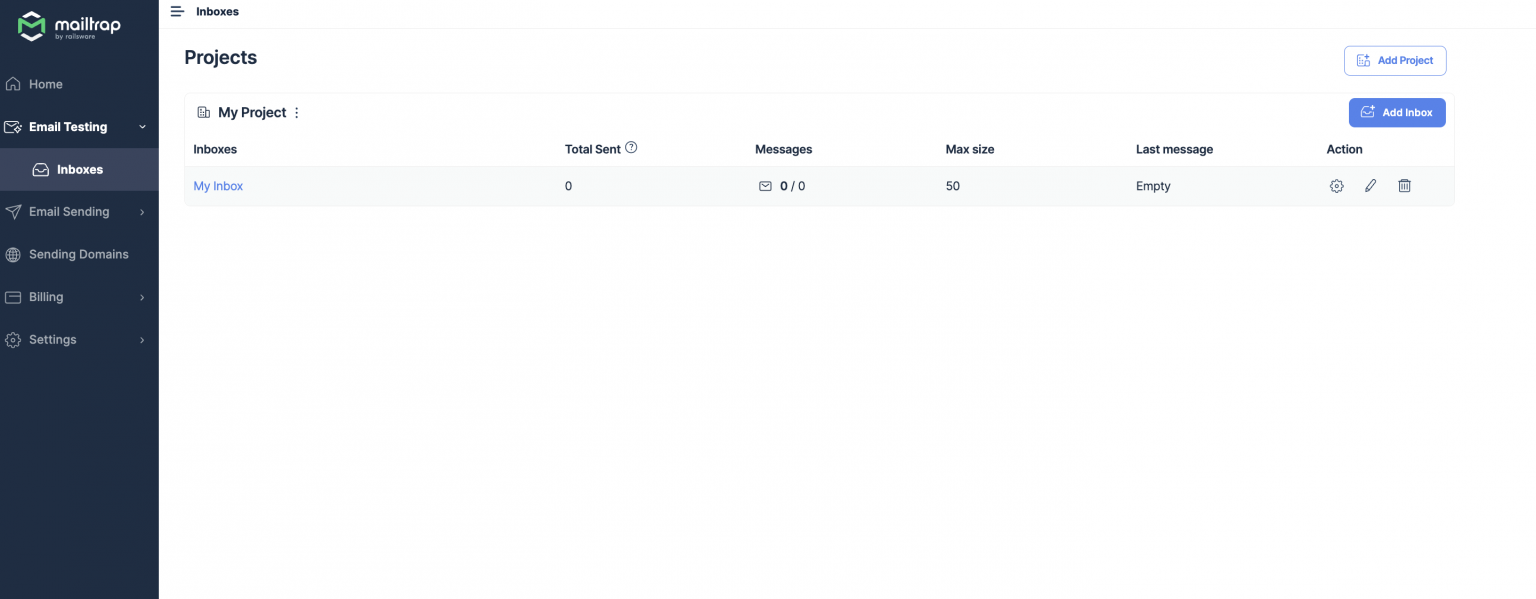
Email templates – Test your templates with our API and then switch from staging to production once you’re ready to dispatch them.

- Automatic authentication – Email Sandbox provides and automatically validates all the necessary DNS records (SPF, DKIM, DMARC). Additionally, DKIM keys are rotated quarterly.
To set up Email Sandbox, you can simply copy/paste the SMTP credentials provided to you after creating an account. Or, if you prefer playing around with code, integrate Email Sandbox into your app with pre-made code snippets and use Testing API for testing, automation, and testing automated sequences.
For a step-by-step tutorial on how to set up Email Sandbox, consult our in-depth Getting Started Guide.
Wrapping up
And with that, we come to the end of our Mailinator tutorial.
I think I’ve covered everything, so hopefully, you can use this article as your go-to Mailinator guide. If you’d like to learn more about the service, I suggest visiting the Mailinator blog.
However, if you’re up for some more high-quality reads on all things email, check out the Mailtrap blog, where you can find articles such as:




